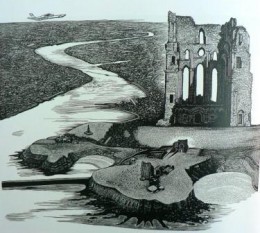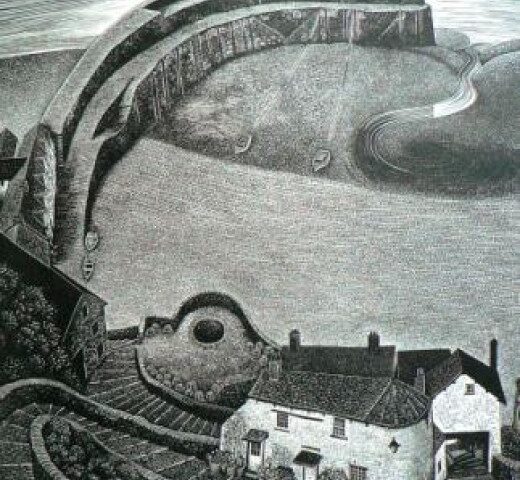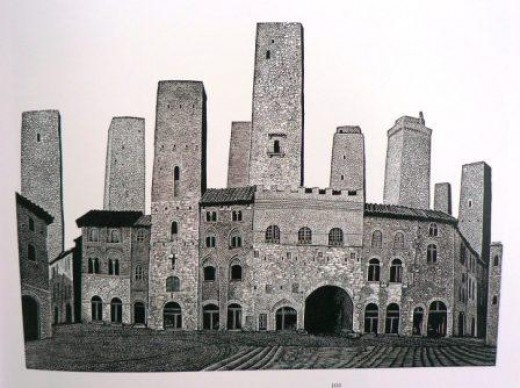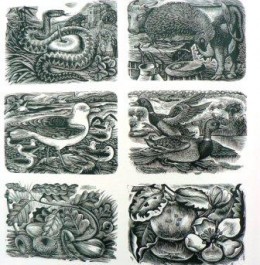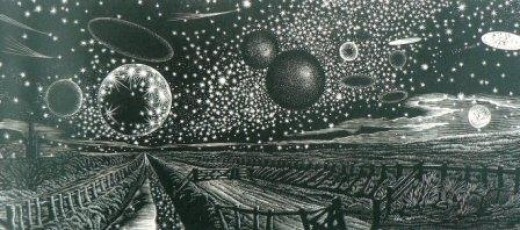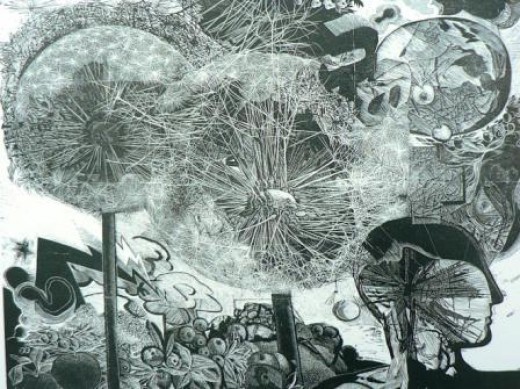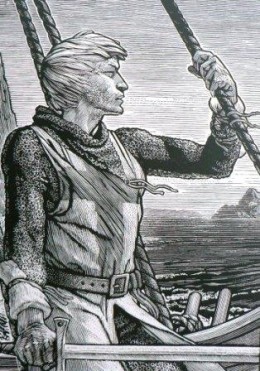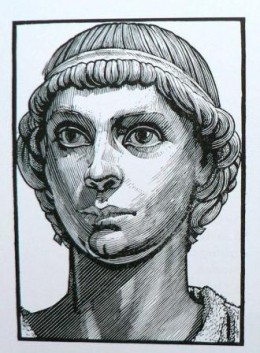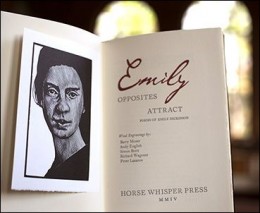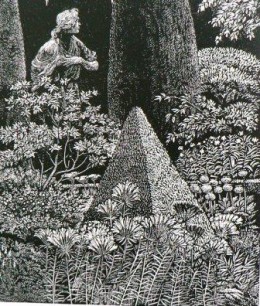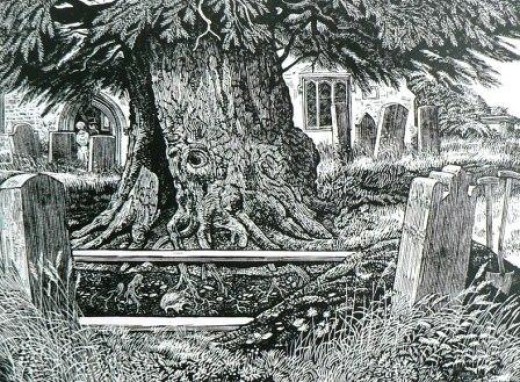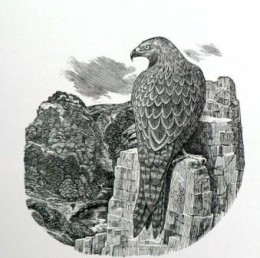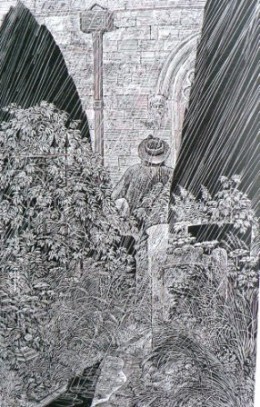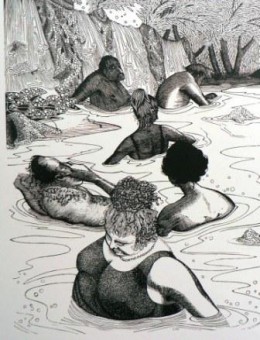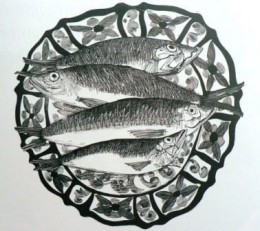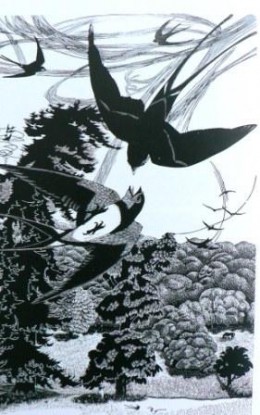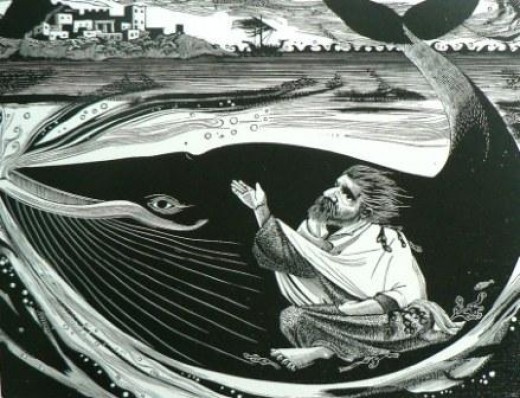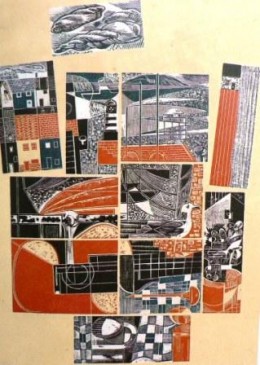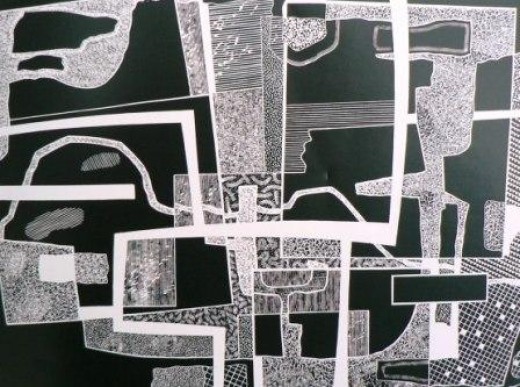Wood Engravers.
 My aim in this article is to introduce you to the art of six contemporary wood engravers whose work represents all that is inspirational to younger engravers and collectors of this art form.
My aim in this article is to introduce you to the art of six contemporary wood engravers whose work represents all that is inspirational to younger engravers and collectors of this art form.
I hope that this article will inspire you to find out more about modern wood engraving, particularly as book illustrations – the most readily accessible way of collecting wood engraved illustrations.
A splinter of wood engravers is the collective noun for this group of artists (I’ve just made this up).
I don’t think there is a collective noun for them! But you can still enjoy looking at their work.
(Images: all taken by me from books in my collection)
Six Wood Engravers
 The work of six wood engravers: Hilary Paynter, George Tute, Simon Brett, Ian Stephens, Sarah van Niekerk, and Peter Lawrence is presented in the book shown opposite: A Being More Intense: the art of six wood engravers, edited by Jenny Pery and published in 2009 by Oblong Creative ltd. (ISBN 9780955 657610) .
The work of six wood engravers: Hilary Paynter, George Tute, Simon Brett, Ian Stephens, Sarah van Niekerk, and Peter Lawrence is presented in the book shown opposite: A Being More Intense: the art of six wood engravers, edited by Jenny Pery and published in 2009 by Oblong Creative ltd. (ISBN 9780955 657610) .
These engravers are all well-regarded in this art field and have all been past chairmen (and women) of the UK based Society of Wood Engravers.
Their work can be found as book illustrations or as self-contained prints.
Hilary Paynter
 Hilary Paynter’s work takes a long distance, or original view, of the landscape and incorporates her own distinctive take on the scene. Her work often comments too, in a witty, satirical or compassionate way, on the human condition.
Hilary Paynter’s work takes a long distance, or original view, of the landscape and incorporates her own distinctive take on the scene. Her work often comments too, in a witty, satirical or compassionate way, on the human condition.
Her early childhood was unsettled as the family moved from one naval posting to another – her father was an officer in the Royal Navy. This , however, exposed her to a broad range of social, cultural and environmental influences that served her well later in life as an artist.
She initially trained as a teacher, taking sculpture and wood engraving as her teaching subjects, and specialised in working with children with challenging and deviant behaviour. She eventually became Head of Special Needs in a comprehensive school in London.
Her interest in wood engraving ran parallel with her career in education and is now predominant in her life. She was Chair of the Society of Wood Engravers between 1998-2006 and was influential in steering its modern direction. Her engravings can be found in the UK Ashmolean, Fitzwilliam and Victoria and Albert Museums, as well as in other major UK city galleries, such as Birmingham, Hereford and Portsmouth.
A recent book has showcased Hilary’s work: ‘Full Circle: Hilary Paynter, Wood Engravings’ by Hilary Paynter and published by Woodend Publishing, 2010. ISBN9780955139741.
Examples of Hilary Paynter’s work

George Tute
 George Tute’s engravings display a rich imagination, featuring deep layers of depth, perspective and meaning in the images he produces. His work is often a fusion of the real and imaginary.
George Tute’s engravings display a rich imagination, featuring deep layers of depth, perspective and meaning in the images he produces. His work is often a fusion of the real and imaginary.
He is also an accomplished watercolour artist and the very different mediums complement and extend each other in his work. The freedom of the watercolour process blends with the precision of wood engraving, to merge in his finished engraved work.
He was born in Hull in 1933, and his interest in art surfaced at grammar school and he studied design to an advanced level at Blackpool and in London, where he studied wood engraving under Gertrude Hermes.
He was a Principal Lecturer in Graphic Design at Bristol Polytechnic and had a major retrospective exhibition of his work at the Bristol Museum and Art Gallery in 1986.
Examples of his work are shown below.
Examples of George Tute’s work

Simon Brett
 Simon Brett attended Saint Martin’s School of Art, London in the early 1960s, where he studied fine art, including engraving. He lived and worked as a painter in New Mexico for a while before returning to Britain and teaching at Marlborough College, Windsor for eighteen years.
Simon Brett attended Saint Martin’s School of Art, London in the early 1960s, where he studied fine art, including engraving. He lived and worked as a painter in New Mexico for a while before returning to Britain and teaching at Marlborough College, Windsor for eighteen years.
He has gained prominence for his striking book illustrations and prints and was commissioned in 1998 to make a presentation print for the Golden Wedding of the Queen and Prince Philip. He has written essays and books on wood engraving (see example below).
His engravings tends to mirror the strengths and weaknesses of people – real or fictional – and his strong interest in history is never far from his work. His subjects often combine ideas or concepts and include sensory experiences (see the religious triage below, incorporating the pain of Christ on the figure below).
Examples of Simon Brett’s work

Ian Stephens
 Ian Stephens gained his artistic skills in illustration and lettering on a National Design Diploma Course in the early 1960s. He then taught art in UK secondary schools before moving into commercial art as a Design Manager and then going freelance in the 1990s.
Ian Stephens gained his artistic skills in illustration and lettering on a National Design Diploma Course in the early 1960s. He then taught art in UK secondary schools before moving into commercial art as a Design Manager and then going freelance in the 1990s.
British landscape and nature themes are a recurring feature of his work and he is interested in the land and how it is shaped and changed by the elements. He is particularly interested in the quiet, often unnoticed corners of the countryside, particularly those he knows well.
He has received many commissions for his engravings (on wood or lino blocks) as book illustrations or prints and was Chair of the Society of Wood Engravers between 1992-95.
Examples of Ian Stephen’s work

Sarah van Niekerk
 Sarah van Niekerk was born in London in 1934 and studied fine art in London art colleges in the early 1950s. She was a tutor of wood engraving at the Royal Academy, and other prestigious UK art schools during the 1970s.
Sarah van Niekerk was born in London in 1934 and studied fine art in London art colleges in the early 1950s. She was a tutor of wood engraving at the Royal Academy, and other prestigious UK art schools during the 1970s.
Sarah is a Fellow of the Society of Painter-Printmakers and was Chair of the Society of Wood Engravers between 1995-98. Her work is featured in many books and her prints are exhibited and sold in galleries across Britain.
Her work is distinguished by its fluid and sweeping lines and which mirror her senses and responses to the scene around her: the movement and cries of birds; the sounds of the countryside; the heat of the day. Her engravings are characterised too, by her attention to detail – note the hairs of the pigs back, illustrated below.
Examples of Sarah van Niekerk’s work

Peter Lawrence
 Peter Lawrence studied Graphic Design/Illustration at the West of England College of Art and has worked in the commercial graphic design world, as an illustrator. However, he did not start engraving until 1990 and fitted this in alongside his full-time employment as Managing Director in an Oxford graphic design company.
Peter Lawrence studied Graphic Design/Illustration at the West of England College of Art and has worked in the commercial graphic design world, as an illustrator. However, he did not start engraving until 1990 and fitted this in alongside his full-time employment as Managing Director in an Oxford graphic design company.
His work – both black and white and in colour – is characterised by its bold abstract design, with detailed sections that are both divided and connected by straight or curving lines. He makes full use of the white – black light spectrum produced by the engraving process to draw attention to the linked elements in his work.
Examples of Peter Lawrence’s work

The Society of Wood Engravers
- Society of Wood Engravers
Find out more about this lovely art form; view more examples of work; make contact with engravers; learn about exhibitions.
Books with wood engravings
- ABEbooks
The biggest site for finding both new and used books. You can do an advanced search using the search term ‘wood engravings’, and including the names of any engravers featured on this article, if interested in their work. - Woodbine Books, Leading Experts On Rare And Collectable Books
My own website – you search using ‘wood engravings’ as a search term


